(Franklin Schaffner, USA, 11 Sept. 1956)
I was really stressed and nervous at the idea of shooting this live episode without any possibility of a second take! I was so anxious that I went to see a doctor who gave me a tranquilizer right before filming.
Marisa Pavan Aumont
“Those we do not bury roam eternally without finding any rest.”
Antigone, Jean Anouilh (1944), Act I, scene 17
Introduction
“Antigone” is a one-hour black-and-white dramatic TV episode, filmed live and produced by the Kaiser Aluminum Hour American series. The 5th episode of the first season, it was directed by Franklin Schaffner and aired on Tuesday, September 11th 1956 on the National Broadcasting Company (NBC) TV station, between 9:30pm and 10:30pm (New York time). Produced by Franklin Schaffner and Worthington Miner, the episode revisits the Greek myth of Antigone, daughter of Oedipus, King of Thebes, and Queen Jocaste (also Oedipus’ mother, hence Antigone’s incestuous grandmother). The episode’s screenplay, written by Lewis Galantiere, is directly based on the modern adaptation of this myth in 1944, in the play Antigone by French writer and playwright Jean Anouilh. Schaffner’s “Antigone” embodies and transposes the myth of a very ancient and classical epoch into a contemporary era whose habits and customs are completely different. It is quite interesting to see how Americans in the 1950’s deal with such a theme for television broadcast, and how the actors, especially Marisa and Claude Rains, play characters whose temperament is explosive, conservative and avant-gardist all at the same time for the relatively conservative society in which they were living. Nevertheless, in spite of their opposite personalities, there is an unconscious link existing between these two characters, a link beautifully depicted in Schaffner’s work, and which is also strongly present between Marisa and Claude Rains. Such a theatrical duality is rarely seen and certainly deserves credit!
About the series…
The Kaiser Aluminum Hour was a series of one-hour black-and-white dramatic TV episodes, filmed live on NBC, and aired on Tuesday nights between 9:30pm and 10:30pm (New York time). The episodes were aired every other week alternately with another series entitled Armstrong Circle Theatre that aired on the same day and at the same time. The first episode of the series was aired on July 3rd 1956, and the last, on June 18th 1957, comprising only one season and 25 episodes, which lasted less than a year. The Kaiser Aluminum Hour was produced by Unit Four Productions, a group composed of producers Worthington Miner, Franklin Schaffner, Fielder Cook and George Roy Hill. Worthington Miner was the founder and executive producer of the series, and other directors such as David Sussking, Alfred Levy, Paul Bogart, Ira Cirker and Paul Lammers were also a part of the series’ success. In September 1956, Marisa had already had the opportunity to work a year and a half earlier with Schaffner on the filming of “Dominique”, an episode also produced by Worthington Miner for the Westinghouse Studio One series, and aired on the Columbia Broadcasting System (CBS) TV station on March 28th 1955. According to J.E. McKillop’s description found on the popular Internet Movie Database (IMDb), the “show had covered both light and serious drama and featured both well-known and not so well-known actors and actresses”, which is exactly the case in “Antigone” with Claude Rains who was already a legend of the screen at the time, and Marisa who was making her debut in television. The series was sponsored by the American firm Kaiser Aluminum, whose advertising slogan was “Kaiser Aluminum – The Bright Stars of Metals”. This business produced all kinds of objects made of sturdy aluminum material, destined for sale. The term ‘Kaiser’, referring to the original name given to German and Austrian Emperors, highlights the solidity of the aluminum materials and the power of the American trade for instance. In 1950’s America, the trade used to make very popular meal trays thanks to the newly-born fashion of TV dinners, a way of buying from the Americans who wanted their own, individual TV dinners so as to enjoy as much as possible the advantages of having a television in their homes. The episode “Antigone” is preceded by such an ad. (1 and 2)
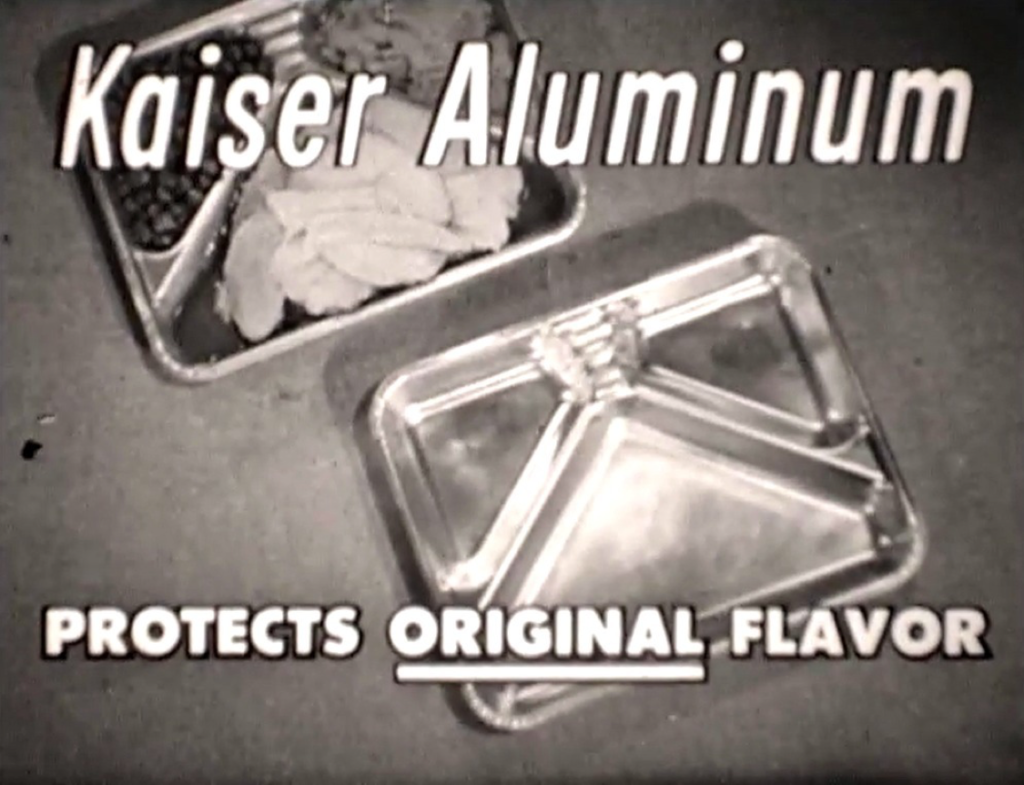
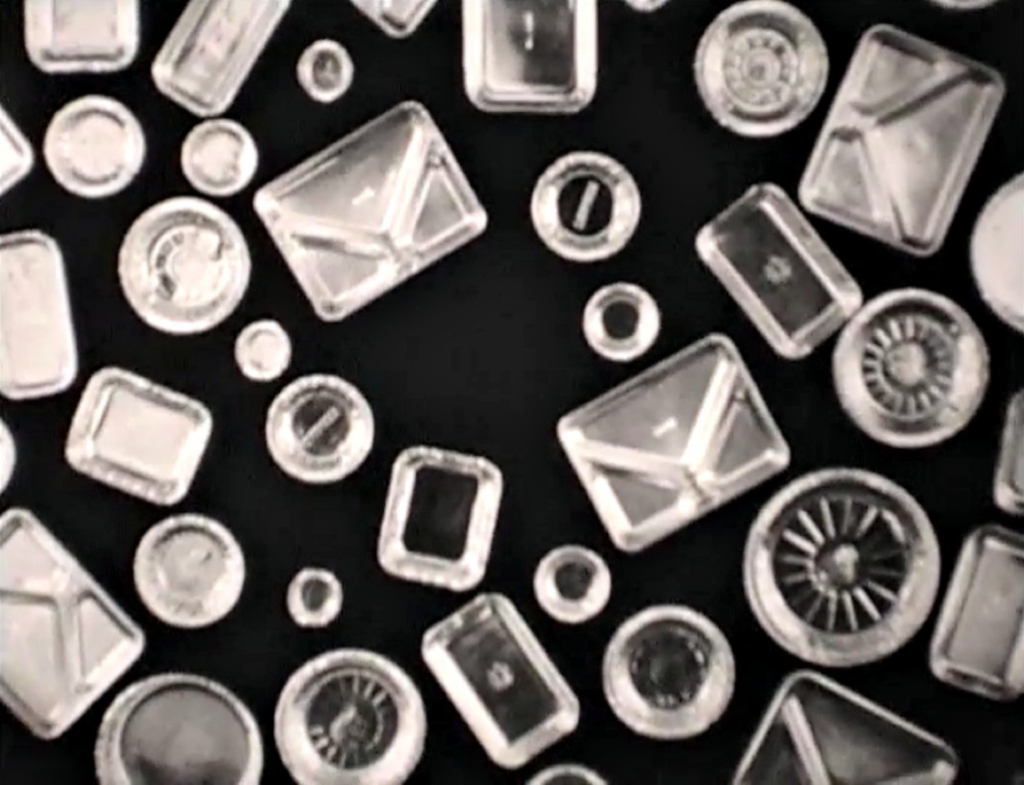
About Franklin Schaffner…
Born on May 30th 1920 in Tokyo (Japan) and deceased on July 2nd 1989 in Santa Monica (California, USA), Franklin Schaffner was one of the most renowned and in demand American directors at the beginning of the television era with his ability to carry out tracking shots, close-ups and interesting camera movements while other directors were performing sequence-shots from a rather fixed camera angle, according to the Internet Movie Database’s website. Nowadays, Schaffner is better remembered for his film The Planet of the Apes which was directed in 1968 and is still considered a classic and one of the best films ever made at the end of the 1960’s. With fifteen or so films to his credit and many television works, he won the Oscar for Best Director in 1971 with Patton, which won 7 Oscars for itself! Schaffner was also TV counselor for the 35th President of the United States, John F. Kennedy. No surprise then that he went on to direct the U.S. election-themed The Best Man(1964).
The myth of Antigone
Allow me to introduce you to the myth of Antigone followed by a summary of its mise-en-scène in both Sophocles’ and Anouilh’s plays. I hope it will help you understand the tumultuous relations between Antigone and King Creon, and appreciate Pavan and Rains’ talent in “Antigone”. This presentation will be illustrated by ideas and arguments picked up in Mohamed El-Sayed Hawash’s academic dissertation, written in French and entitled Le mythe d’Antigone chez Sophocle et Jean Anouilh, a dissertation presented at the Faculty of Graduate Studies and Research of the University of Manitoba in Winnipeg (Canada) and composed in October 1976. It is important to know that the myth of Antigone has engendered the creation of a lot of literary, poetic, theatrical, musical and cinematographic works throughout the centuries than just those of Sophocles and Anouilh, obviously. A considerable number of writers, critics, poets and playwrights such as Robert Garnier (16th Century), or, more recently, Jean Cocteau, Léon Chancerel, and even composer Míkis Theodorákis, have also adapted the myth of Antigone under various forms of art, yet always conforming with the contemporary society in which they were living, paying a very particular attention to it. However, Anouilh’s play, which was written and performed during World War II, can thus be easily considered a gate between two temporally-distant worlds yet very linked to each other with themes like rebellion, risk, disobedience, but also love and faith. These themes are transposed in a world in the grip of rebellion through Anouilh’s work to be then adapted and broadcasted on American TV channels a decade after the end of World War II, in an utopian consumer society which has not known all the ravages and horrors of the war on the European continent. Before digging any further into Sophocles’ and Anouilh’s work, here is a summary of the origins and story of Antigone… Firstly, the tragic story of Antigone follows that of her father Oedipus, King of Thebes. The myth of Oedipus, better remembered nowadays through the psychological concept of the Oedipus complex coined by famous Austrian doctor and neurologist Sigmund Freud, is a part of what is commonly called “La malédiction des Labdacides”. Oedipus is the son of King of Thebes Laïos and his wife, Queen Jocaste. As a baby, Oedipus is cast an evil divine spell on which destines him to murder his father and marry his mother in the future, without his knowing. According to the myth, this curse would have been engendered by Chrysippus’ father, Chrysippus being a young man who would have been kidnapped by Laïos for homosexual purposes. Horrified by this curse, the King and the Queen decide to abandon their child after having his feet drilled (whence his name Oedipus etymologically meaning “swollen foot” in Greek). The child is then entrusted to Polybus and Merope, King and Queen of Corinth by the servant in charge of abandoning Oedipus. Several years later, Oedipus is being told by an apparently drunk Corinthian that he was adopted by his parents and learns at the same time the curse he is carrying inside of him. Convinced that Polybus and Merope are his biological parents, Oedipus leaves Corinth and meets on his way out of the city an old man asking him a bit too curtly to stray from his path. Cut to the quick, Oedipus kills him without knowing that he has just killed his own father, Laïos. Once in Thebes, he succeeds in answering the Sphinx’s enigma who has been spreading terror on the city ever since, and who commits suicide shortly afterward. Oedipus is made King of Thebes by the inhabitants of the city to thank him for having provoked the Sphinx’s death and then marries the Queen, newly a widow of Laïos, his own mother. They then have four incestuous children together: Eteocles, Polynices, Ismene and Antigone. Later, when Oedipus finds out what he has done, he leaves Thebes, disgraced and humiliated, and plucks his eyes out. Antigone’s story then begins… After accompanying their father Oedipus for a long time until his death, Antigone and her older sister Ismene come back to Thebes where they witness the continuous quarrels of their brothers Eteocles and Polynices concerning the access to the throne of the city. Both brothers finally set up an agreement that they would be reigning alternately, but at the moment when Eteocles has to step aside for Polynices, he suddenly refuses, thus provoking a war launched by his brother against him and Thebes. Eteocles and Polynices both die fighting, and Creon, brother of Queen Jocaste and uncle of Oedipus and Antigone, becomes the new King. Antigone’s rebellion starts when Creon decides to organize funerals worthy of that name for his nephew Eteocles, but to let Polynices’ dead body ‘rot’ in full nature because of his betrayal. Very emotionally attached to her family and to the religious traditions, Antigone refuses this situation and rises up against Creon. For her, Polynices was her brother as was Eteocles, thus he has the moral right to be buried just like his brother following the usual religious rituals. It is unthinkable that Polynices’ body be left uncovered! The major part of all the literary and artistic works relating to the myth of Antigone deals with the confrontation between Antigone who rebels and contests her uncle’s decision, and Creon, who attempts to chasten his niece and advise her that she can be sentenced to death if she insists upon acting against him. After receiving numerous warnings from Creon, Antigone finally decides to disobey him and bury her brother despite the interdiction. Her story ends up when she is put to death by her own uncle. The way she dies, however, varies according to the different adaptations of the myth. Another character who plays an essential role when Antigone dies is Haemon, son of Creon and Antigone’s fiancé. Deeply affected by the death of his beloved fiancée, he commits suicide directly on her body at the end of the myth. Ismene also tries to kills herself after her sister was sentenced to death. This love between Antigone and Haemon, who are in fact cousins, is obviously accentuated in Schaffner’s “Antigone” (for Americans do like to accentuate love stories, right?!)
The myth of Antigone in Sophocles’ play
Sophocles composed his play Antigone in 442 B.C., as part of a trilogy with the tragedies Oedipus the King and Oedipus in Colonus. After going through the summaries of the five acts of Sophocles’ play in Mohamed El-Sayed Hawash’s thesis, I noticed that the myth of Antigone is worked on with much poetry despite the tragedy. Antigone confronts Creon several times but she is also keen to talk to her sister Ismene about her feelings, her sister who, in spite of being outraged by Creon’s decision, refuses to disobey him. Haemon threatens his father to kill himself if he keeps his plan to sentence Antigone to death. When a seer named Teiresias, who is escorted (or symbolized) by a child, informs Creon that having a dead body ‘rot’ would offend gods and religious rituals of Thebes, he strongly advises him to “reconsider his decision” (El Sayed Hawash, p-13) in order to prevent any other divine tragedy. Creon finally agrees with the seer’s proposition and decides to bury Polynices. Unfortunately, it is too late! Antigone has hung herself with the belt of her gown in the hole where she was supposed to stay locked up until her death. Seeing his son Haemon in the hole, the latter spits in his face before sinking a blade in his tummy. Poetry and the divine atmosphere are thus dealt with in Sophocles’ play, in addition to the main confrontation between Antigone and Creon.
The myth of Antigone in Anouilh’s play
Jean Anouilh thought of and wrote his play Antigone in 1942 and it was performed at the Théâtre de l’Atelier in Paris, in 1944. According to Mohamed El-Sayed Hawash’s thesis, several differences are noticeable in Anouilh’s play in comparison to Sophocles’. The main difference is with the settings. In Sophocles’ play, the action takes place in Thebes, before Creon’s palace, whereas in Anouilh’s play, the settings are more neutral, with only a few plain doors surrounding the characters. The confrontation sequence between Antigone and Creon is still extremely intense but some passages and divine characters such as Teiresias have been removed. Instead, Anouilh adds the Nurse, to whom Antigone confides a lot, as well as several body guards. A decision that was probably made to replace the number of priests and seers with an atmosphere closer to the reality of World War II. The character of Antigone in Anouilh’s play is more partial to the stereotype of a teenager or young adult rebelling against authority in general, rather than a wise, spiritual and conservative woman as seen in Sophocles’ play.
“Antigone”: the mise-en-scène of a youthful rebellion against authority
“Antigone” is unlike typical TV episodes filmed in the United States at that time. It is indeed much more theatrical in its screenplay, settings, costumes as well as the scripted moves and acting. (Based on a play you’re going to tell me!) The youthful rebellion against authority witnessed in the episode deals with the contestation of the law launched by Creon, new King of Thebes, to let his nephew Polynices’ dead body ‘rot’ as he was considered a traitor and patriarchal enemy. Antigone, niece of Creon and sister of Polynices, rises up against her uncle and follows through with her idea to bury her brother the way he morally deserves it. Her unfortunate rebellion is then condemned by Creon, which would bring her to death ever after. The episode is edited in a rather funny way as it starts after about four minutes of ads for the Kaiser Aluminum trademark, cut in-between by the opening credits of the episode. After the opening ad for the trademark, the opening credits of “Antigone” appear, with the actors standing motionless in the background, or sometimes walking from one side of the stage to the other, like zombies. Polynices’ dead body, covered in a simple undergarment, is laying on a modern wooden structure slightly raised to allow the spectator to see Polynices’ dead body exposed to the lights of the ceiling just as if it was exposed to the sun according to the myth. Body guards wearing helmets and dressed in black are standing motionless beside the structure, whereas all the other actors are standing, motionless as well, in the background. Then, a second ad for the aluminum American TV dinners appears onscreen before the episode starts proper. The way the episode is presented is also original and results in something theatrical, cinematic and televisual all at the same time. Alexander Scourby, the narrator, tells us the essential elements of the story so we are able to understand the characters’ dialogues. He is the narrator of the story of Antigone from the beginning, during and at the end of the episode. Scourby is either filmed motionless facing the camera and spectator or wandering on stage where the characters are frozen in time and space or filmed closer and closer. (3) During and at the end of the episode, he is escorted by a young boy, whom he calls “My lad” and who only talks towards the very end of the episode, answering Creon with the following words: “I don’t know Sir…” or “Oh yes Sir!”. This child is somewhat intriguing and fascinating because we do not know which character he is performing. A young pupil or guide of Creon’s? A family member? An angel? Teiresias? Or simply the symbol of a youth which has to obey the grown-ups and be respectful toward authority?
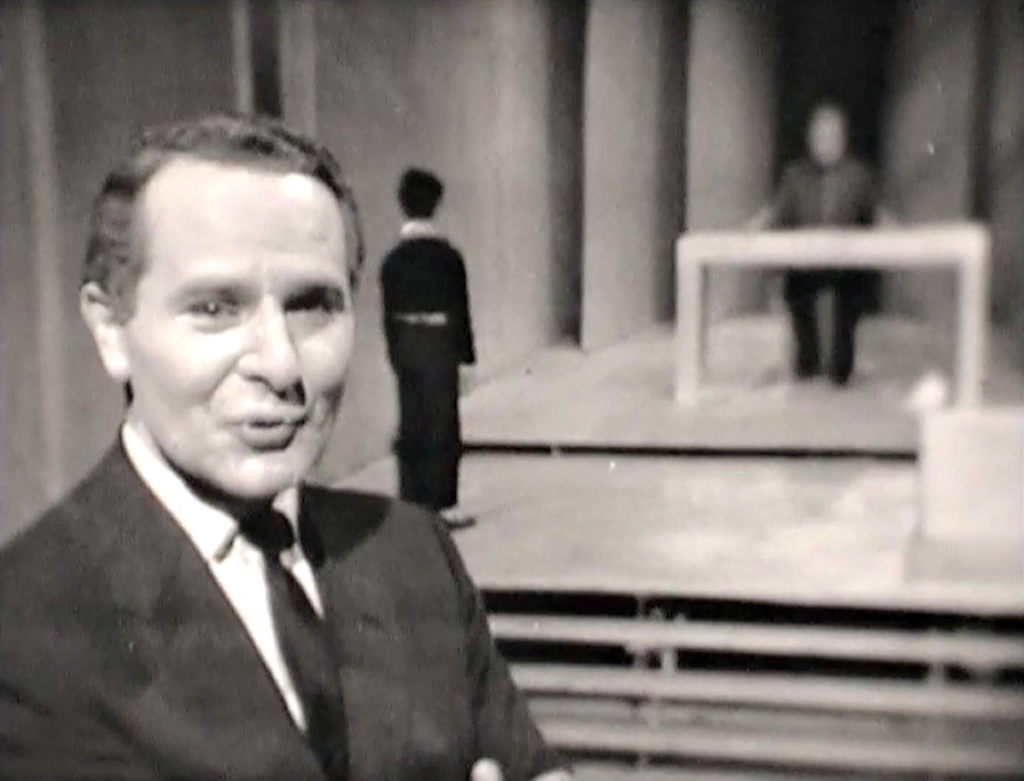
When he first appears, Scourby introduces us to the plot of the story as well as the past and characteristics of each character. As he is precisely describing the characters, they are filmed in… close-up! Obviously! Because Schaffner just loves close-ups as we can notice it in “Dominique”. Scourby is commenting the actions that are about to happen with a particularly sarcastic sense of humor and an absolutely amazing acting. His comical acting talent is so innate that he is able to make us laugh about tragic themes. When he is explaining that Antigone is destined to marry Haemon: “Antigone and he are engaged to be married”, he adds: “They… won’t be of course…” with half a smile and an ironically natural tone in his voice as if he was talking about something insignificant, holding his cigarette in his hand throughout the entire episode. Scourby’s introductions can symbolize the acts of a play about to be performed, which highlights once more the very theatrical atmosphere, yet we are thrown into Schaffner’s cinematic atmosphere and we do feel his presence and that of his on-the-shoulder camera, ready to catch every sign of a facial expression from the actors, whereas Scourby gets under the skin of a TV host. A very interesting mix of styles which appeals to the spectator. All the actors are dressed up in a modern style compared to the era of the myth, which is not the case for Marisa in Solomon and Sheba(King Vidor, 1959) with the use of ancient costumes. Here, both Scourby and the actors are wearing clothes dating back to the World War I era. You will notice while watching the clips that even the actors’ acting, and especially that of the guards, can remind one of the atmosphere of terror in a Europe destroyed by World War II. The episode is divided into three main parts. The first and longest of them all is that of the confrontation between Antigone and her uncle Creon. In each of them, dialogue is the most important and praised element in the episode and it is furthermore put forward by an intense dramatic fashion from the actors who are all very talented and convincing in their respective roles. As always, the dialogue and the numerous signs of affection are filmed with an “échelle de plans” that varies every other minute. Schaffner usually starts by filming a duo of characters in a full shot, then moves closer to a medium shot to finally end on close-ups on their faces, before getting back to a medium shot. The zooming function did not exist yet back in 1956, and Schaffner had a clear preference for tracking with his camera on his shoulders. He must not have liked tripods much. His (numerous) close-ups emphasize Marisa’s dramatic expressions. In the first part, Antigone confides a lot in her nurse (played by Mildred Natwick) about her intention to bury Polynices despite her uncle’s interdiction. In the presence of her nurse, Antigone appears almost like a child. She is lively, malicious and a bit hot-headed and disobedience does not scare her. Far from it! Their complicity is thus filmed through a close-up! (4) She even drives her nurse nuts by making her believe she has met a new lover.
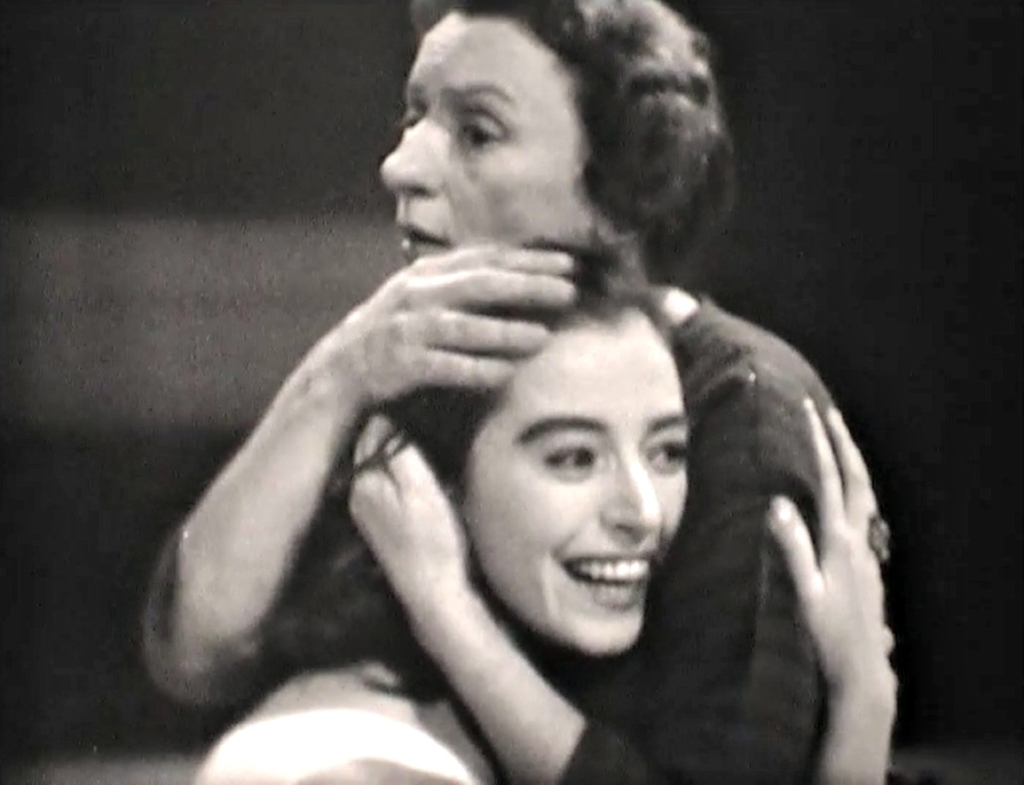
When her older sister Ismene (played by Felicia Montealegre) appears, she seems to be a much more mature and down-to-earth woman and tries to chasten her sister and convince her that she should not go against Creon and his authority. Far from understanding it in this way, Antigone leaves to join her fiancé Haemon. Despite the intense love between the two, Antigone orders him to leave her if he really loves her but without offering any rational explanation. At this precise instant (and not only at this instant by the way but during the whole show), Antigone has only one goal in mind: to properly bury her brother Polynices. (Clip n°1) When a guard hurries to inform the impetuous Creon, played by talented British film and television legend Claude Rains, that someone had covered Polynices’ dead body with a handful of earth, the latter loses his temper and orders the guard to arrest the guilty the next time.
Clip n°1 – Antigone and Haemon (Marisa and Paul Stevens)
The second part begins when Antigone, leaning over Polynices’ body and caught in the act of betrayal, is arrested by Creon’s guards. The one who had mainly informed Creon and arrested Antigone is played by Clint Young. His character has dark humor and even makes fun of Antigone’s claim that she is the daughter of Oedipus. Antigone is then brought up in front of Creon and a long dialogue between the two characters takes place. Creon appears unexpectedly calm before Antigone whom he considers a stubborn niece who has to calm her hormones and rebellious temper down. Filmed both together and separately, and always following Mr. Schaffner’s varying and particular “échelle de plans”. Antigone and Creon quarrel for a long time with each of them refusing to give up. Antigone is also surprisingly calm at the beginning of the confrontation, even though she totally disagrees with her uncle. As for Creon, he is formulating every argument possible in order to make her realize that her brother was a traitor. According to him, he was pitiless and even violent towards his own family. Aged only two when Polynices was killed, Creon cannot understand why Antigone has such love for her brother and believes that she is only there to provoke him and challenge his authority. While exposing his arguments, Creon insists upon the fact that he does love and care for his niece. He even wishes her a long and happy life with his son Haemon, a beautiful life she would be the only one to refuse due to her stubbornness. Even if he shows his sweet and comprehensive side, Creon is formal: if his niece keeps refusing to obey the law, he would have to have her killed, and this is not what he wants. However, Antigone knows her duty and keeps opposing Creon. Her duty is to bury her brother and she knows she will do it, no matter the consequences and no matter if that automatically implies her death. Rains and Pavan’s acting is here so strong that it goes beyond words. You have to watch it to know what I mean! Marisa turns into a provocative rebel and her moments of silence are only there to help her formulate the arguments/lines of her character to throw them into Rains’ face! Rains’ acting, although different from Pavan’s, is truly genuine and beautiful and shows us a character/actor whose attitude seems calm but whose tone, look and facial expressions are threatening and put us somehow ill-at-ease, which makes us want to obey him. Thus, the continuity of this duality becomes frightening. (Clip n°2) The episode is mostly built on duality in general, and it is very rare that three or more characters are having an important conversation for a long time.
Clip n°2 – Antigone and Creon (Marisa and Claude Rains)
The third and last part of the episode begins when Antigone starts yelling louder and louder at Creon’s face as if a bomb had exploded inside of her! Her rebellion is at its peak and her screams even alert her sister Ismene who appears in a completely different state of mind than earlier. She was probably eavesdropping… Ismene is now on Antigone’s side and even wants to bury Polynices herself, which leads to a brief quarrel between the two sisters. Ismene does not imagine life without Antigone and agrees with her decision. Creon then orders his guards to arrest his nieces to sentence them to death. We do not know more about Ismene’s fate… In all the existing adaptations of the myth of Antigone, Ismene’s fate varies. She might have been sentenced to death, she might have committed suicide or she might have been pardoned… (Clip n°3)
Clip n°3 – Antigone, Creon and Ismene (Marisa, Claude Rains and Felicia Montealegre)
When Haemon learns about Antigone’s sentence, he hurries to present himself in front of his father and threatens him to kill himself if Antigone is to die. Creon acts the same way with his son than Antigone, that is, with a calm yet powerful and authoritarian tone. Seeming not to believe his son, he finally lets him go. We then acknowledge Antigone’s presence underneath the wooden structure on which Polynices’ body is laying, waiting for her unfortunate death. She is calm yet saddened and devastated. She is wondering how she is going to die. “Locked up alive in a hole!” the guard tells her with sadistic pleasure. When her turn comes, the guards take her and her tearful screams pronouncing the words: “I’m not ready yet!” simply tear at the viewer’s heart strings. The episode ends on Scourby’s last appearance when he tells us the end of the story. The awful end, the one we do not see, and do not want to see… Antigone has hung herself with the belt of her gown. When Creon entered the cave, he saw his son Haemon kneeling down in front of his lover’s body with his head buried in the folds of her gown before suddenly stabbing himself in the tummy in front of his father. No music is ever heard during the teleplay. Scene changes, atmosphere and the stronger moments such as Antigone’s arrest by the guards or her death sentence are punctuated by drum beats. Faithful to Anouilh’s play, the settings remain simple: a central stage usually found in television studios, a wooden and slightly curved structure, a few ladders, transparent curtains, a few chairs and a formal desk of the King’s palace. Everything is placed on the main stage, each corner corresponding to a place: Antigone’s room, the outside where Polynices’ body is exposed and Creon’s kingdom. Every character is dressed in black and white to respect the simplicity of the atmosphere in Anouilh’s play. The dialogues are a combination of formal and authentic sentences and modern expressions which are often related to the usual stereotypes of father-daughter or uncle-niece relationships, especially when Creon tells Antigone: “Go to your room!” with a natural authority. The simplicity and authenticity of Anouilh’s work are thus represented in the episode through which we can notice the originality of Schaffner’s tracking shots as well as the typical TV mise-en-scène of the series and drama programs of the 1950’s, with a host and a cast of actors.
Marisa or Antigone… The one who dared say “NO!”
Aged 24 at the time of filming, Marisa plays the role of… (Well, I have not mentioned it earlier on purpose!) Antigone! It is a role that I think suits her very well for her personality echoes that of Antigone on numerous points. Marisa often told me that she had always been in a kind of rebellion since childhood. She could not stand being told what to do and how to act. “I was a rebel with my father… I didn’t want him to tell me what to do!” Marisa tells. She also did not like to get duped by the studios. “I had a real temper indeed…”. Thus, Marisa gets under the skin of the character of Antigone with an ease worthy of the grandest dramatic actresses. (5, 6, 7 and 8) Two (almost identical) personalities meet and give rise to sincerity in actions, words and emotions onscreen. Marisa’s acting had never been as intense as in this episode. We feel as though we are watching a professional dramatic actress with many years of experience behind her. At the time of filming, Marisa had already done seven films and four TV episodes. She is a real prodigy in “Antigone” because, being an Italian herself and a lover of the classical era, her Latin and Greek studies in Italy and her pronounced taste for classical music as well, emphasize the theatrical atmosphere of the episode with her acting, without stealing the show from Claude Rains and the other actors. Her performance is truly wonderful and from her past experiences and strong yet sensitive personality, she was able to perform perfectly the one who dared say “NO” to Rains.
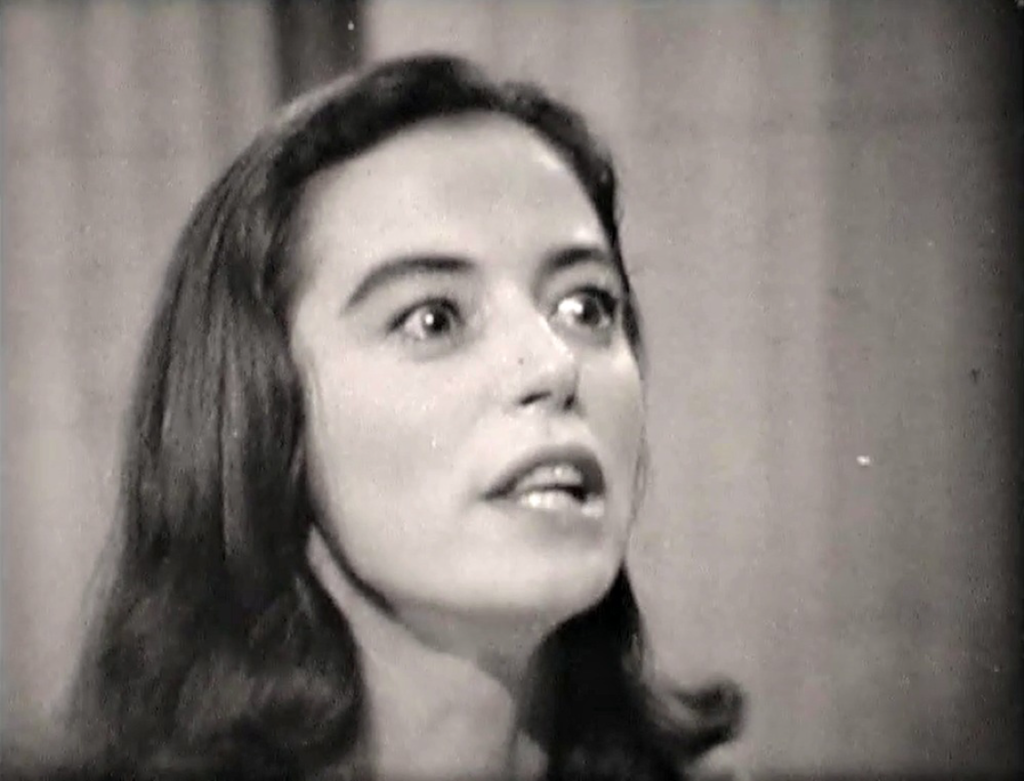
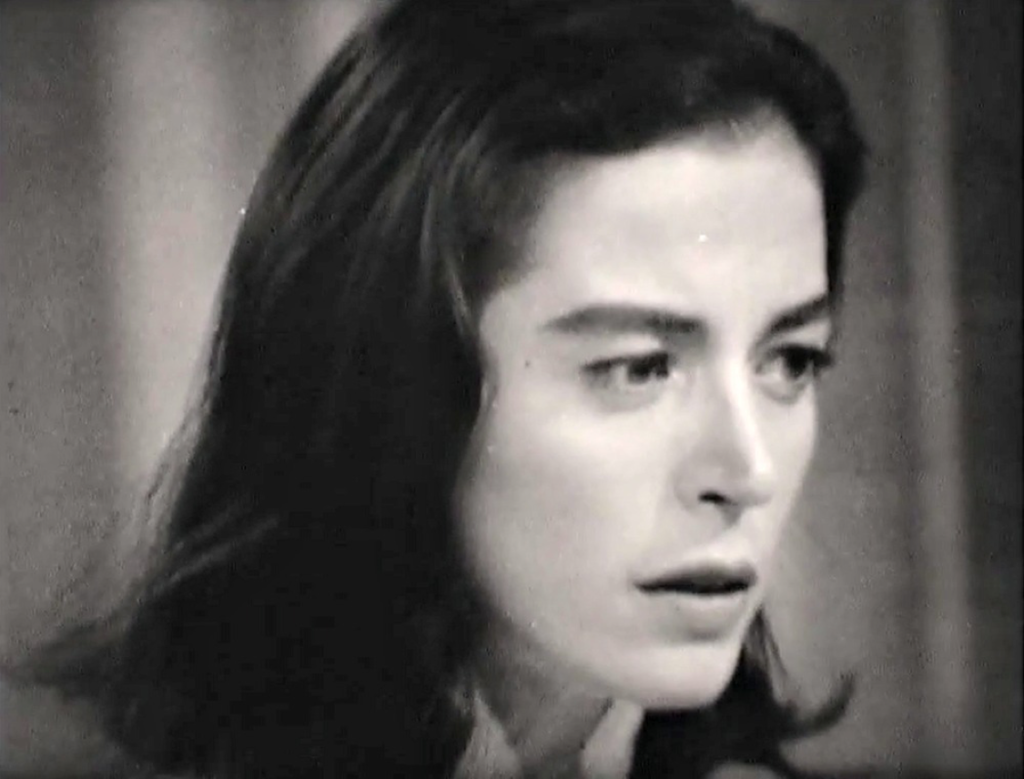
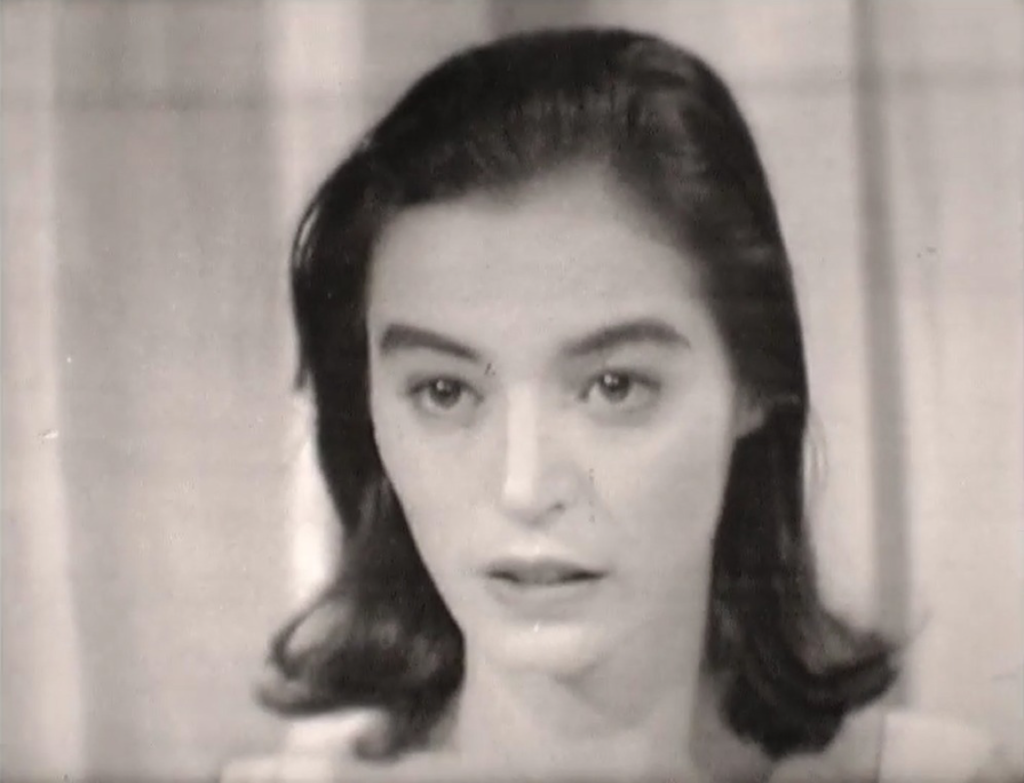

Personal opinion
It is with great pleasure and enthusiasm that I recommend this episode to you, an episode in which all the actors, and especially Marisa and Claude Rains, offer us a remarkable dramatic performance. This episode will please lovers of drama and literature but also cinephiles and lovers of ‘Golden Age’ TV with its mise-en-scène and shots that bring the spectator physically and emotionally close to the characters/actors. For everyone eager to experience the depth of Marisa’s dramatic talent, this episode will satisfy. The only thing that is missing in my opinion is a musical score and I also would have enjoyed watching more scenes, moves and physical actions from the characters.
A few words from Ralph Schiller about “Antigone”…
Long-time admirer of Marisa and her twin sister, actress Anna Maria Pierangeli (known worldwide as Pier Angeli), Ralph Schiller, author of The Complete Films of Broderick Crawford (published in 2016), has kindly shared with me his opinion as a writer, movie lover and fan of the Golden Age of Hollywood about “Antigone” and Marisa’s role in the episode. Here is his review: “‘Antigone’ was a live, one-hour episode of the Kaiser Aluminum Hour that was telecast September 11, 1956. It survives today in a grainy, black and white telecast. Originally based on an ancient Greek play by Sophocles, it was translated and re-written by Jean Anouilh. It was adapted for television by Lewis Galantiere and skillfully directed by Franklin Schaffner. ‘Antigone’ is a modern, avant-garde presentation of the Greek tragedy produced with bare minimum sets with the cast wearing early 20th Century costumes but it is brilliant. The narrator (in modern Western suit and tie) and chorus for the drama is exquisitely played by the man with the golden voice, Alexander Scourby. Magnificent screen legend Claude Rains is the pragmatic King Creon in a role he was born to play. Marisa Pavan gives an absolutely stunning and heartbreaking performance as the star-crossed princess Antigone. The middle third of the entire play is a superb confrontation scene between Claude Rains, with his majestic voice, and Marisa Pavan. Rains always commands the screen or stage, but he and Pavan compliment each other with great skill in this explosive, withering scene. Marisa Pavan, at the age of 24, is at the peak of her beauty, and already an accomplished actress.”
Anecdotes and memories from Marisa
First of all, I wish to thank Marisa from the bottom of my heart for allowing me to discover “Antigone”, which I had not had the chance to view while carrying out research. Special thanks goes to Jean-Claude Aumont as well for burning the episode to DVD. From then I was able to burn it as a video file and watch it from my computer a couple of weeks after my visit to Marisa’s. Therefore, it is with great pleasure that I am introducing you to three clips from the episode in this article. You are more than welcome to contact me through the website if you wish to watch the entire episode. Remembering the filming of this episode, Marisa shared some surprising anecdotes with me: “I was so stressed and nervous at the idea of shooting this live episode, a one-hour long episode on top of that, that I was beginning to feel sick. It is an experience even more difficult than the shooting of a full-length film because you aren’t allowed a second take, and everything happens much faster. I was so anxious that I went to see a doctor who gave me a tranquilizer. Unfortunately, the pill had a too-relaxing, nay chilling effect on me only a few minutes before the shooting started, and I almost forgot my lines! Do you realize?! The pill had this awful, undesirable effect on me, and I can tell you that I was completely panic-stricken from then on, and much more frightened by these last-minute memory lapses than by my first stress. It was unbearable! In the end, the shooting of ‘Antigone’ went on in one go and quite smoothly, with such a charming cast and crew. Once we are thrown into our lines and character, we are not thinking of anything else besides our work. I went back to see my doctor when the shooting was done telling him: ‘It is the last time that you stab me in the back! No more of this!’ Marisa says, laughing. Besides this more-or-less traumatic experience, Marisa also recalls Claude Rains’ extreme kindness and sensitivity, whom she has shared intense, dramatic and wonderfully-played scenes with.
Sources
Author of the article: Margaux Soumoy
Help with the English translation: Philippe Spurrell
TV episode
The Kaiser Aluminum Hour “Antigone” (Season 1, episode 5). Directed by Franklin Schaffner, produced by Worthington Miner & Franklin Schaffner, teleplay by Lewis Galantiere, based on the play Antigone by Jean Anouilh, Unit Four Productions, National Broadcasting Company (NBC), USA, 11 Sept. 1956, sd. English, B&W, 60 min
Cast: Claude Rains (Creon), Marisa Pavan (Antigone), Mildred Natwick (The nurse), Alexander Scourby (The narrator/chorus), Paul Stevens (Haemon), Clint Young (A guard), Felicia Montealegre (Ismene)
Episode burnt to DVD by Jean-Claude Aumont
Episode on DVD courtesy of Marisa Pavan Aumont
Episode on DVD burnt to computer as a video file by Margaux Soumoy
Creation & video editing: Margaux Soumoy with Movie Maker on Windows 10
Creation of the GIF (Graphics Interchange Format): Margaux Soumoy with Giphy
Screenshots: Margaux Soumoy
Academic reference
Hawash, Mohamed El-Sayed. “Le Mythe d’Antigone chez Sophocle et Jean Anouilh”, Oct. 1976, Networked Digital Library of Theses & Dissertations, p. 1-14, p. 41-44
Interviews & comments
Pavan Aumont, Marisa. Interview with Margaux Soumoy, 22 Sept. 2016, phone
Schiller, Ralph. Review of the episode “Antigone”, 2 Dec. 2016, Facebook Messenger
Websites
Needham, Col. Internet Movie Database, 17 Oct. 1990
http://www.imdb.com/title/tt0618436/
http://www.imdb.com/title/tt0048880/
http://www.imdb.com/name/nm0769874/
The Classic TV Archive
http://ctva.biz/US/Anthology/KaiserAluminumHour.htm
Monnier, Maël. « Le mythe d’Œdipe – Qu’est-ce que c’est le mythe d’Œdipe ? – Antigone de Jean Anouilh – Bac de Français », Page d’accueil de Maël, 2 Feb. 2003
http://mael.monnier.free.fr/bac_francais/antigone/mytheoedipe.htm
Busnel, François, et al. « Antigone, celle qui a dit non / Les Grands Mythes », Arte, 31 Aug. 2016
http://sites.arte.tv/grands-mythes/fr/antigone-celle-qui-dit-non-grands-mythes
Marteinson, Peter. « Anouilh – ANTIGONE », french.chass.utoronto.ca, 1998
Technical details
GIF
Dimensions: 480 x 270px
Size: 9958KB
Frames: 171
Dimensions of the screenshots
1 – 994 x 763px
2 – 994 x 763px
3 – 997 x 761px
4 – 995 x 763px
5 – 998 x 763px
6 – 999 x 761px
7 – 996 x 763px
8 – 996 x 763px